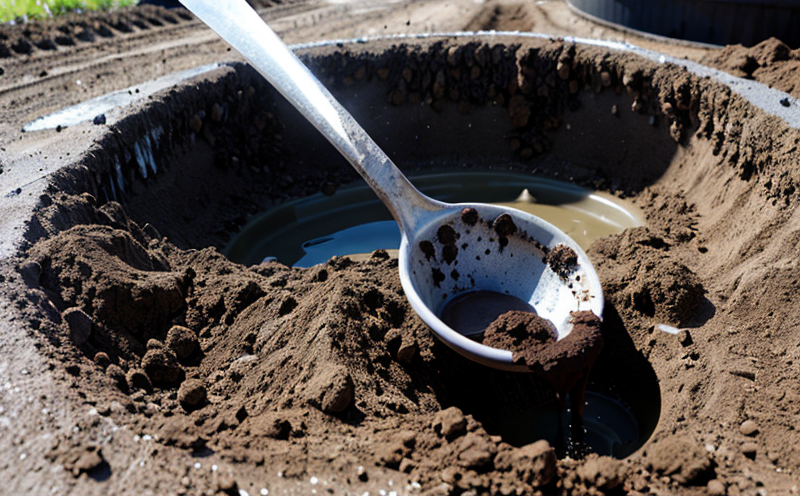EPA 608 Organochlorine Pesticides in Sludge Test
The EPA Method 608 is a critical regulatory test used to analyze organochlorine pesticides present in sludge. This method provides comprehensive data on the presence and concentration of these pesticides, which are known for their persistence in the environment. The test is particularly important for environmental monitoring and compliance with environmental regulations set forth by the U.S. Environmental Protection Agency (EPA).
Organochlorine pesticides are a class of insecticides that were widely used before they were banned due to concerns about their toxicity and long-term environmental impact. These pesticides can persist in soil, water, and air for extended periods, making them a significant concern for environmental health. The EPA Method 608 is designed to ensure that the levels of these persistent organic pollutants (POPs) are within acceptable limits as set by regulatory bodies.
The test involves several steps, including sample collection from various sludge sources, extraction methods to concentrate the pesticides, and instrumental analysis using gas chromatography with mass spectrometry (GC-MS). This sophisticated analytical technique allows for precise quantification of multiple organochlorine compounds simultaneously. The method is capable of detecting even trace amounts of these pesticides, ensuring accurate data that can be used for regulatory compliance.
The EPA Method 608 is not only a technical procedure but also a stringent quality assurance process. It requires meticulous sample preparation and handling to ensure the integrity of the test results. This includes using appropriate solvents, maintaining cold chain conditions during transport, and employing standard operating procedures (SOPs) for all steps in the analytical process.
The importance of this method cannot be overstated, especially given its role in safeguarding public health and environmental quality. By adhering to EPA Method 608, laboratories can provide reliable data that helps decision-makers assess risks associated with sludge use or disposal. This information is crucial for ensuring compliance with various regulatory standards, such as the Resource Conservation and Recovery Act (RCRA) and other local, state, and federal regulations.
In conclusion, EPA Method 608 plays a vital role in environmental protection by providing accurate and reliable data on organochlorine pesticides present in sludge. Its rigorous nature ensures that all stakeholders can make informed decisions about the safe handling and disposal of sludge, thereby minimizing potential environmental hazards.
Benefits
- Data Accuracy: Utilizing EPA Method 608 guarantees precise detection and quantification of organochlorine pesticides in sludge samples.
- Compliance Assurance: This method ensures that all test results meet the stringent standards required by regulatory bodies like the EPA.
- Risk Assessment: Reliable data from this test aids in assessing potential risks associated with sludge use or disposal practices.
- Environmental Protection: By ensuring compliance, this method helps protect public health and environmental quality.
Why Choose This Test
The EPA Method 608 is a cornerstone of regulatory compliance for organizations dealing with sludge. Its comprehensive approach ensures that all relevant organochlorine pesticides are identified and quantified, providing stakeholders with the confidence needed to make informed decisions.
This method offers several advantages over other testing protocols. Firstly, it uses advanced analytical techniques like GC-MS, which provide high sensitivity and selectivity for detecting even trace amounts of contaminants. Secondly, its standardized procedures ensure consistent results across different laboratories, enhancing reliability and trustworthiness of the data generated.
Moreover, EPA Method 608 supports risk assessment by offering detailed insights into potential environmental impacts. This information is invaluable for developing effective mitigation strategies that can address any identified risks promptly. By choosing this test, organizations not only comply with regulatory requirements but also contribute to sustainable practices and responsible waste management.
International Acceptance and Recognition
EPA Method 608 is widely recognized both domestically and internationally as a benchmark for the analysis of organochlorine pesticides in sludge. Its acceptance by regulatory authorities worldwide underscores its credibility and reliability.
The method aligns with international standards such as ISO, ASTM, EN, IEC, and others, ensuring compatibility with global best practices. This alignment facilitates seamless integration into various national and regional compliance frameworks, promoting consistency across jurisdictions.
Organizations that adopt EPA Method 608 can leverage its broad acceptance to enhance their reputation for quality and reliability. By adhering to this internationally recognized standard, they demonstrate a commitment to environmental stewardship and regulatory compliance, which is increasingly important in today's global market.





